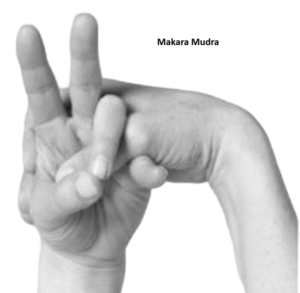Makara Mudra
Introduction
Makara Mudra is an ancient yogic hand gesture rooted in mudra therapy and Ayurveda, associated with strength, vitality, and energy conservation. The word Makara means “crocodile” in Sanskrit—a creature symbolizing primal energy, endurance, and survival power. Just as the crocodile waits patiently yet possesses immense hidden strength, this mudra is believed to awaken dormant energy reserves within the body, especially when one feels drained or fatigued.
It is commonly used in yoga therapy for restoring vitality, grounding energy, and strengthening the kidneys and adrenal glands, which are considered sources of deep life force (ojas).
Meaning
Makara = Crocodile (symbol of primal power, deep waters of subconscious, vitality).
Mudra = Gesture, seal.
Thus, Makara Mudra means “the gesture of the crocodile”, representing the hidden strength and survival energy within us.
How to Perform (Practice)
Sit in a comfortable position such as Sukhasana, Vajrasana, or Padmasana. Keep your spine straight and shoulders relaxed.
Practise in any position. Join the tips of your left thumb and ring finger. Bring the right thumb between the ring and little finger of your left hand and place its tip on the base of your left thumb. Bring your right palm flat against the back of your left hand.
Hold for 5–10 minutes three times daily.
Close your eyes, breathe deeply, and focus on the sensation of inner energy reserves awakening.
Hold the mudra for 5–15 minutes, up to 2–3 times daily.
Benefits
Physical Benefits
Strengthens kidneys and adrenal glands (vitality organs).
Restores energy during exhaustion, fatigue, or burnout.
Supports recovery from chronic illness or weakness.
Improves blood circulation and oxygen supply.
Boosts immune system functioning.
Energetic Benefits
Awakens ojas (vital essence) and life force.
Balances prana and apana vayu (upward and downward energies).
Grounds scattered energy and stabilizes the aura.
Helps in root chakra (Muladhara) activation.
Mental & Emotional Benefits
Increases confidence, stability, and resilience.
Reduces stress and anxiety linked to fatigue.
Promotes inner calmness and patience.
Encourages endurance during long-term challenges.
Contraindications
Should be avoided in high blood pressure (can increase inner heat and circulation).
Not recommended for people with excessive inner restlessness or hyperactivity.
Pregnant women should practice only under expert supervision.
Avoid prolonged holding if experiencing palpitations or dizziness.
Anatomy & Physiology
Works on endocrine system, especially adrenal glands.
Enhances oxygen utilization by improving blood flow.
Strengthens renal circulation and supports detoxification.
Stimulates parasympathetic nervous system to restore balance after fatigue.
Kinesiology
Right thumb (fire element, energy source) is locked into the left hand (support, stability), symbolizing energy conservation.
The pressing of the thumbs creates a closed energy loop, preventing energy loss and redirecting it internally.
Hand and forearm muscles engage lightly, enhancing awareness of strength and grounding.
Neurology
Stimulates vagus nerve → promotes calmness and recovery.
Activates brain centers for energy regulation.
Strengthens the hypothalamic-pituitary-adrenal (HPA) axis, reducing fatigue.
Improves neuro-muscular tone and helps regulate body’s energy expenditure.
Duration of Practice
5–15 minutes, 2–3 times daily as needed.
For therapeutic purposes, practice consistently for 4–6 weeks.
Best used during times of exhaustion or low vitality.
Counter Mudra
Prana Mudra → enhances energy and immunity.
Apana Mudra → for grounding and detoxification.
Shakti Mudra → to calm hyperactive energy after Makara practice.
Conclusion
Makara Mudra is a powerful revitalizing gesture that draws upon hidden reserves of energy, much like the crocodile resting silently but bursting with strength when required. It strengthens the kidneys, adrenals, and vitality, restores balance during fatigue, and promotes resilience in body and mind. As a therapeutic mudra, it is particularly useful for individuals who feel burned out, weak, or energetically drained, helping them to reconnect with their inner strength and endurance.
FAQ
Q1. What is Makara Mudra best for?
It is most effective for restoring vitality, overcoming fatigue, and strengthening the kidneys and adrenal glands.
Q2. Can it be practiced daily?
Yes, but preferably in short sessions (5–15 min).
Q3. Does it help with anxiety?
Yes, indirectly—by reducing fatigue and stabilizing energy, it calms the mind.
Q4. Is it safe for everyone?
Generally yes, but those with high blood pressure or hyperactivity should avoid overuse.
Q5. Which chakra does it influence?
Primarily the Muladhara (Root Chakra) and Manipura (Solar Plexus Chakra).
References
Gertrud Hirschi – Mudras: Yoga in Your Hands.
Swami Satyananda Saraswati – Asana, Pranayama, Mudra, Bandha.
K. Rangarajan – Yoga Mudras: Gestures for Healing and Spiritual Growth.
Ayurveda texts on ojas and kidney-adrenal connection.
Modern research on mudra therapy for fatigue and stress management.

